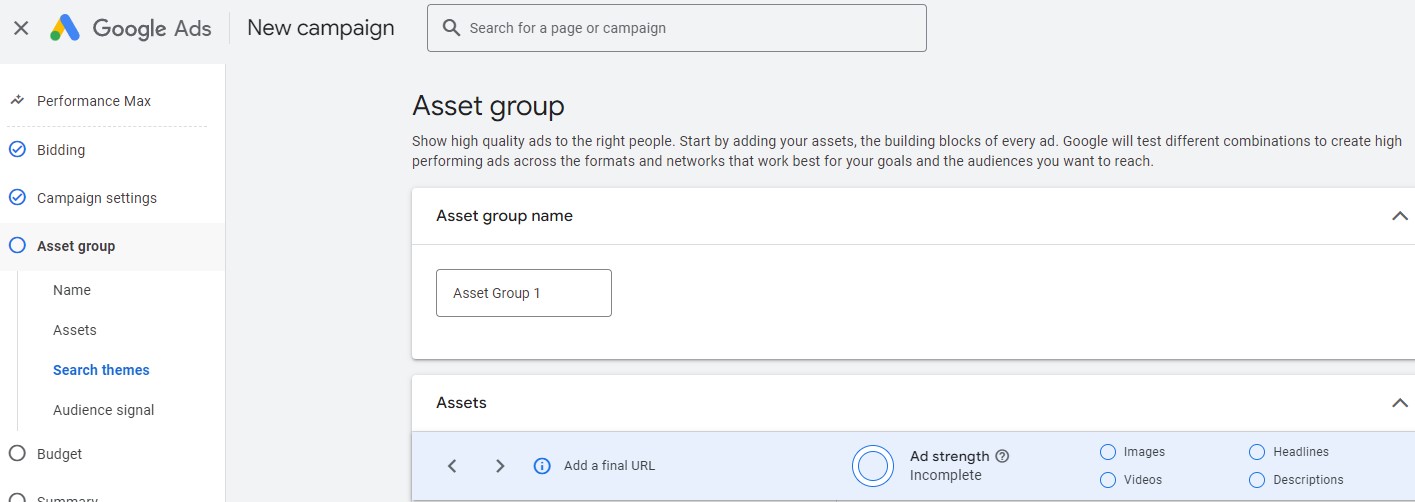Performance Max Search Themes streamline search campaigns by allowing advertisers to give Google additional signals for better targeting, moving beyond the traditional reliance on keywords and manual adjustments.
This direct approach ensures ads match with searches more accurately, based on the expected customer search behavior.
The key benefits include:
- Automatic Ad Placement Optimization: Ads are automatically placed across Google’s platforms like YouTube, Search, and the Display Network for optimal visibility and reach.
- Unified Campaign Management: Simplifies advertising with a unified system that enhances ad performance and efficiency.
- AI-Powered Targeting: Utilizes AI to refine targeting, making campaigns more effective over time by learning which strategies resonate best with the target audience.
This concise, focused approach maximizes ad relevance and impact, significantly improving ad efficiency.
Setting Up Performance Max Search Themes
Launching your first Performance Max Search Theme is straightforward. By following these steps, you can ensure your campaigns are set up for success, leveraging Google’s AI to reach your target audience efficiently.
Pick a Performance Max campaign.
Choose an Asset group. Different Asset groups can have their own audience signals and search themes.

- In your Asset group, look for the “Signals” section below your ad assets.

You’ll find the Search Themes beta here. You can add up to 25 unique search themes for each Asset group to boost your Performance Max campaign’s signals. Remember, each search theme should be under 80 characters.
Save and review the search themes.
Bonus Content: If you want to learn how to exclude unwanted placements from performance max campaigns, you can read our article!
How Do Search Themes in PMax work?
Here is a brief explanation of the functioning of search themes in PMax:
- Choose Keywords: Pick keywords that match what your customers are searching for. Search themes add an extra layer for targeting, on top of your usual settings like URLs.
- Add Themes: You can add 1 to 25 themes per asset group, tailoring your ad targeting.
- Direct Customers: These themes help guide customers to your chosen web pages, ensuring they land where you want them to.
- Match Ads to Searches: Like with keyword matching, search themes influence which ads pop up based on user searches.
- Exclude Brands: You can block your ads from showing up with certain brands or keywords, keeping your ad placements relevant.
- Get Insights: Find out which search terms work best and how they’re performing, with options to customize your data review period and even download the data for deeper analysis.
- Remove Themes: If needed, you can easily remove themes from your asset group.
Bonus Content: Learn more about adding audience signals to PMax campaigns which is one of the most important features in Google Ads.
The Pros and Cons of Performance Max Search Themes
| Advantages | Disadvantages |
| Targeting Efficiency | Limited Control and Insights |
| Broader Google Network Reach | Risk of Cannibalization |
| Dynamic Optimization | Challenges with Negative Keywords |
| Simplified Management | Reporting Limitations |
Incorporating Performance Max Search Themes into your digital marketing strategy can significantly impact your campaign results. It’s important to understand both the benefits and challenges to fully use its potential.
Advantages:
Targeting Efficiency: Google’s AI ensures your ads reach the most relevant audience, enhancing targeting.
Broader Google Network Reach: Your ads appear on Search, YouTube, and Display Network, maximizing visibility.
Dynamic Optimization: AI continuously optimizes your campaigns for better performance over time.
Simplified Management: Unifies various advertising efforts, making campaign management easier.
Disadvantages:
Limited Control and Insights: You may find yourself with little control over settings and unclear on specific performance drivers, leading to a sense of being lost.
Risk of Cannibalization: Without careful monitoring, Performance Max could overshadow the achievements of other campaigns.
Challenges with Negative Keywords: The inability to fine-tune targeting with negative keywords may lead to targeting inefficiencies.
Reporting Limitations: Limited details on budget allocation and performance across channels can obscure insights.
Understanding these aspects helps you make well-informed decisions about integrating Performance Max Search Themes into your marketing strategies.
Solving Common Challenges with Performance Max Campaigns
Tackling PMax challenges effectively means identifying specific hurdles and applying focused strategies to overcome them. Here are common problems and their solutions:
Challenge 1: Brand Traffic Competition
Solution: Exclude your brand keywords from Performance Max campaigns to avoid bidding wars over your own brand, keeping brand-related traffic cost-effective.
Challenge 2: Limited Creative Variety
Solution: Enrich your campaign with diverse text, image, and video assets. For videos, utilize tools like Canva for easy animation creation, enhancing your ad’s appeal across Google’s platforms.
Challenge 3: Inadequate Data Feed
Solution: For e-commerce, ensure your Merchant Center feed is detailed and current, focusing on precise product identifiers and rich descriptions to boost campaign effectiveness.
Challenge 4: Insufficient Optimization Efforts
Solution: Regularly analyze and test your campaign’s elements, from ad copy to landing pages, to discover optimization opportunities and refine strategies based on performance data.
Challenge 5: Campaign Goal Conflicts
Solution: If you’re marketing diverse product lines or services, split them into separate Performance Max campaigns tailored to specific goals, facilitating more targeted advertising and budget management.
Challenge 6: Neglecting Audience Signals
Solution: From the outset, integrate audience signals like in-market and remarketing lists to sharpen targeting, offering more personalized ads and improving conversion rates.
Challenge 7: Weak Performance on Certain Platforms
Solution: Keep tabs on the source of your Performance Max traffic. If specific platforms lag, reassess budget distribution or tweak ad creatives for better alignment with platform preferences.
Bonus Content: Here are our related articles that you might be interested:

































